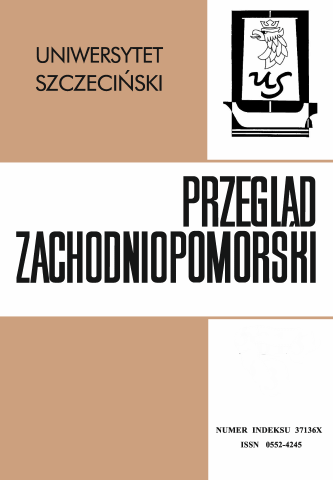Funkcje gospodarcze miast dorzecza Wieprzy i Grabowej i ich zaplecze rynkowe w drugiej połowie XVIII wieku
Economic Functions of the Towns in the Drainage Basin of the Wieprza and Grabowa Rivers and their Market Background in the Second Half of the 18th Cen
Author(s): Kazimierz KallaurSubject(s): History
Published by: Wydawnictwo Naukowe Uniwersytetu Szczecińskiego
Keywords: Pomerania; towns; economy
Summary/Abstract: The area chosen for the analysis encompasses the Sławieński (Schlawe) County within its limits from 1725, with its varied economic structure, with its diversifi ed legal status of land estate (royal, municipal,gentry). The main objective of the paper is the analysis of the economic functions of four towns situated in the County: Darłowo, Sławno, Sianów, Polanów (Rügenwalde, Schlawe, Zanow, Pollnow), and the market relations in the second half of the 18th century. When the economic relations were stable, the number of the population of the Sławieński County was increasing steadily. On the eve of the Seven Years’ War in 1756 the County had 23,500 inhabitants, and in 1798 already over 33,000, of which 42% lived in gentry’s estates, 35% in the Darłowo domain, 17% in towns, and 6% in the municipal estates of Darłowo and Sławno. There were attempts to solve the problem of how to accommodate the steadily growing population by increasing the density of housing within the town’s walls, which consisted in fi lling on all the urban empty spaces in a different layout, at the same time following the new building and fi re regulations. An important feature of the urban changes was transferring farm buildings outside the town’s walls. Darłowo, Sławno and Sianów, as independent legal and organisational units, came under the state authority, and Polanów was a gentry’s town. Darłowo was a town where for the majority of the inhabitants agriculture and cattle breeding was the main occupation and income source, but crafts and commerce and other services played an important role too. Sławno – the County capital – with its social structure and its every-day life looked like an agricultural village, and the local crafts and commerce based on the guild system only supplemented the inhabitants’ income sources. In Polanów and Sianów, which were towns only legally and not in the socio-economic sense, agriculture and animal breeding were the main occupation of the inhabitants and their main income source. In the local turnover, in addition to agricultural produce, a signifi cant role was played by products of the local crafts, and the commerce of agricultural produce, of building, ship and fi rewood, of forest products, and services. The production thereof satisfi ed the local market demand and was sold at the local fairs. The biggest share in the market sale constituted beer and liquor, cloth (also wool cloth and linen), leather and blacksmith’s ware. Darłowo derived signifi cant profi ts from port duties, from marine commerce and from shipbuilding. The rate of socio-economic growth of the towns situated in Sławno County and their market background in the second half of the 18th century, in comparison to the period between the Thirty Years’ War and the Seven Years’ War, was caused by several reforms carried out in towns, state and municipal estates and by the revival of commodity and monetary exchange on the local, regional and international markets, which was accompanied
Journal: Przegląd Zachodniopomorski
- Issue Year: 28/2013
- Issue No: 02
- Page Range: 5-46
- Page Count: 42

